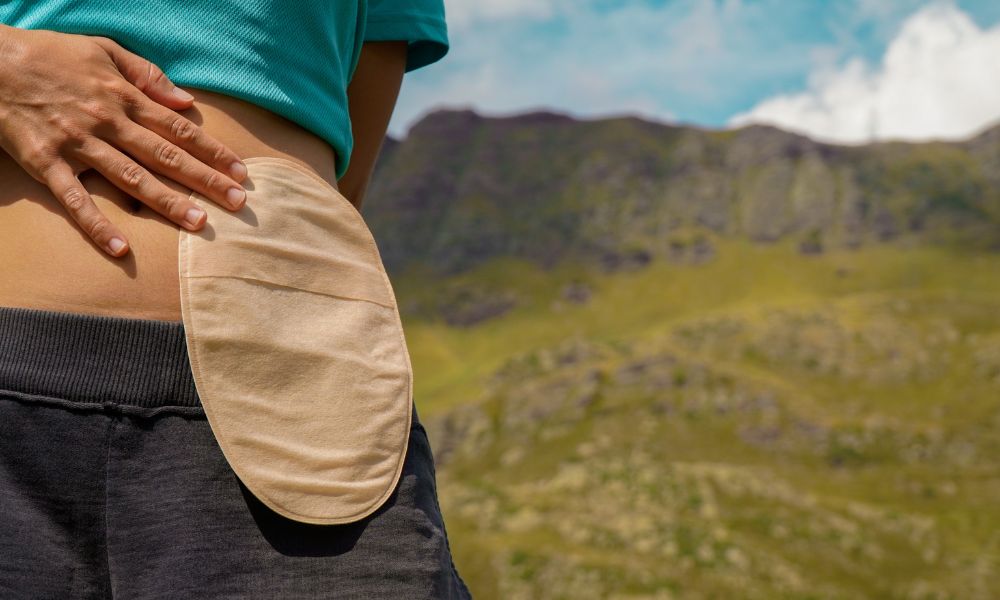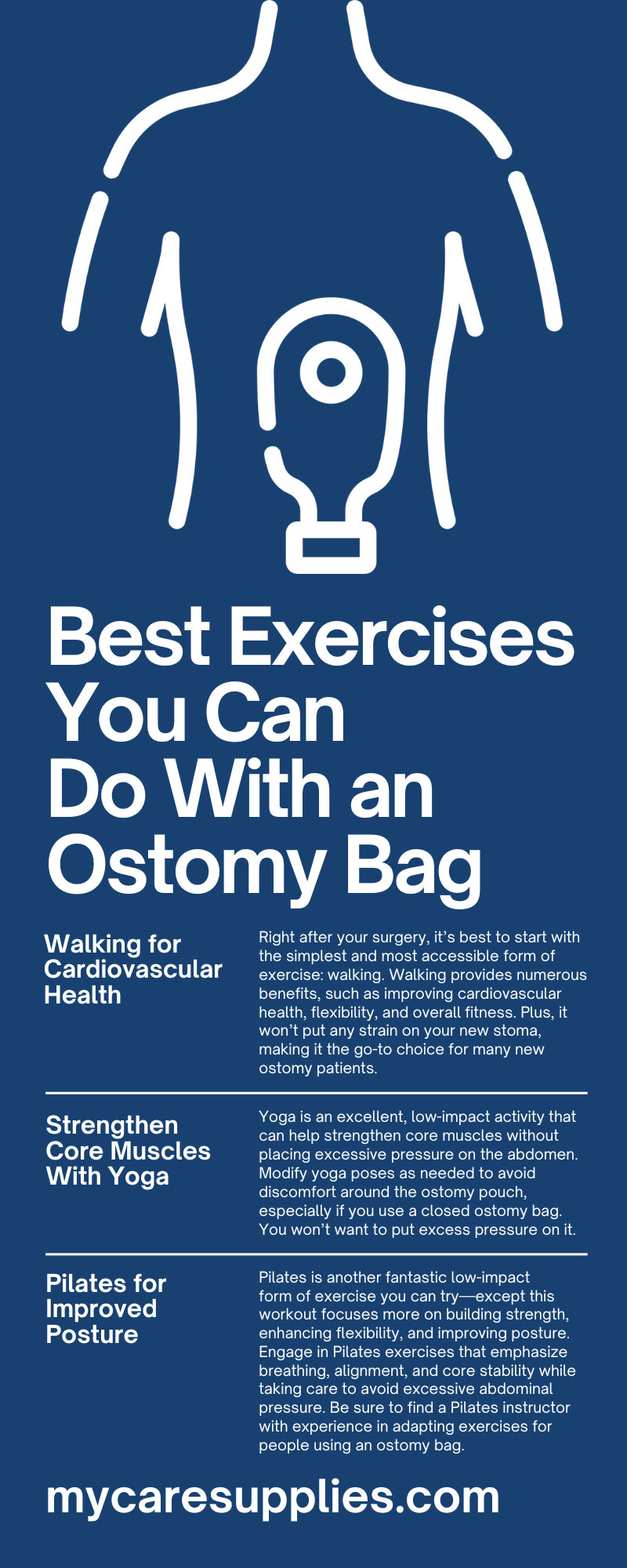9 Best Exercises You Can Do With an Ostomy Bag
Posted by Jeanne Lowry on Oct 4th 2023

When most people get diagnosed with a major medical issue, it tends to be a bit of a wake-up call for them to do something about their physical health. This is something that many people consider after having an ostomy surgery. While a stoma might not be the direct result of poor health choices, many people still use it as a motivation to make a change.
However, after this kind of surgery, you’ll need to consider how your ostomy pouch might affect things. Fortunately, staying fit won’t be a problem with the right knowledge and careful preparation. To help get you started, we’ve compiled a list of exercises you can do with an ostomy bag. We hope these serve as a good jumping-off point for you during your road to recovery.
Walking for Cardiovascular Health
Right after your surgery, it’s best to start with the simplest and most accessible form of exercise: walking. Walking provides numerous benefits, such as improving cardiovascular health, flexibility, and overall fitness. Plus, it won’t put any strain on your new stoma, making it the go-to choice for many new ostomy patients recovering from surgery.
It’s a good idea to begin by walking at a comfortable pace, gradually increasing the duration and intensity to build stamina and endurance. Remember to wear a supportive ostomy belt to secure the bag during this kind of physical activity.
Strengthen Core Muscles With Yoga
After your stoma has healed a bit more, you can start looking into strengthening your core. Yoga is an excellent, low-impact activity that can help strengthen core muscles without placing excessive pressure on the abdomen. Modify yoga poses as needed to avoid discomfort around the ostomy pouch, especially if you use a closed ostomy bag. You won’t want to put excess pressure on it. We highly recommend seeking guidance from a certified instructor trained in adapting yoga for individuals with unique needs.
Pilates for Improved Posture
Pilates is another fantastic low-impact form of exercise you can try—except this workout focuses more on building strength, enhancing flexibility, and improving posture. Engage in Pilates exercises that emphasize breathing, alignment, and core stability while taking care to avoid excessive abdominal pressure. Be sure to find a Pilates instructor with experience in adapting exercises for people using an ostomy bag.
Low-Impact Aerobics for Fitness
Aerobic exercises are generally ones that improve your larger muscle groups while also boosting your heart health. Many of these workouts, however, cause excessive impact on your joints and abdomen. That’s why you should try some low-impact activities, such as swimming, water aerobics, or gentle dance classes.
Since these activities can help improve cardiovascular health without causing unnecessary strain on the ostomy site, they are among the most popular for recovering ostomy patients. While either at home or at a fitness facility, you can perform these activities safely and effectively, ensuring a beneficial and enjoyable workout experience.
Cycling for Cardio and Leg Strength
Once you’ve progressed further into your recovery, you can try cycling for better cardio training. Indoor or outdoor cycling can provide an effective cardiovascular workout while also improving leg strength without putting undue stress on your ostomy. Be sure to adjust the bike’s seat height for comfort and practice proper form to ensure a safe and enjoyable cycling experience with your ostomy bag.
Resistance Training for Muscular Strength
If you really want to work your muscles, it’s still possible to do resistance training with a stoma. You just need to be careful not to push yourself too hard when doing it. You can do this by utilizing resistance bands, light dumbbells, or bodyweight exercises while always practicing proper form and avoiding excessive force around the ostomy site. Seek guidance from a fitness professional experienced in working with individuals with a stoma if you’d like further assistance.
Stretching for Flexibility and Mobility
Even though our list of the best exercises you can do with an ostomy bag primarily focuses on cardio and strength-building workouts, we can’t stress enough the importance of stretching to improve flexibility and mobility. Before any exercise, perform gentle stretches, focusing on major muscle groups while avoiding direct pressure on the abdomen. Outside of exercising, though, you can incorporate stretching into your daily routine for improved posture, balance, and overall well-being.
Mindful Meditation for Mental Well-Being
Of course, an important thing to remember through all of this is that your mental health is just as important as your physical health. For mental exercises, you can incorporate mindful meditation into your fitness routine since it can bring numerous mental health benefits. Practicing mindfulness can help manage stress, improve focus, and promote a positive outlook.
Techniques such as deep breathing, progressive muscle relaxation, and visualization can be effectively used without causing any form of discomfort or pressure on your stoma. Remember, mental health is just as important as physical health, and a calm mind can significantly enhance your overall well-being. If you’re new to meditation, consider seeking guidance from a mindfulness coach or using a mindfulness app designed for beginners.
Tai Chi for Balance and Stress Reduction
If you want to combine your physical and mental training, consider integrating Tai Chi into your exercise regimen. This ancient Chinese martial art is known for its slow, deliberate movements and its emphasis on breath control. Tai Chi enhances balance control, reduces stress, and promotes mental tranquility, all without putting significant strain on the ostomy bag.
As with the other exercises mentioned, ensure to adjust and execute movements in a way that avoids discomfort around the ostomy site. Since Tai Chi may be unfamiliar to you, it may be beneficial to start with a qualified instructor who can guide you through the movements and help adapt them to your personal needs. Once you have the basics down, you can also practice it at home.
Incorporating Exercise Into Your Daily Routine
Speaking of which, the key to all of these exercises is consistency. While this isn’t an exercise suggestion, it’s something we feel is necessary for recovering ostomy patients to keep in mind. In order to reap the benefits of any exercise regimen, you must remain consistent with it. The best way to do this is by incorporating a few minutes of exercise into your daily routine and gradually increasing the duration as your strength and confidence grow.
You might find it useful to create a schedule that alternates between different types of exercises to ensure a balanced approach that targets various aspects of fitness.
Remember that listening to your body is paramount; never push yourself to discomfort or pain, especially in the abdominal area. If you feel discomfort or pain, you may not be using the right accessories for your activities. Keep in mind the importance of hydration and proper nutrition, too. As always, consult with a healthcare professional before starting any new fitness program to ensure it won’t conflict with your recovery.


